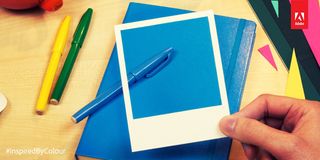Reasons we all see colours differently
Today we're celebrating colour in design, speaking to Adobe's Rufus Deuchler about the fascinating world of colour perception.
Designers are also going to see different colours depending on their screens...
You're talking about colour calibration, and you can chose to make it as simple or complex as you want.
What calibration really means is that you take the information from your camera or scanner, your computer and the printer, and make sure there's colour consistency between all these devices.
There's another step, all of your apps that you use need to be, not calibrated, but respecting the colour profiles that you've chosen for the calibration of the device. So it's almost overwhelming when you think of all the things you need to change to make a total calibrated workflow.
I've personally always gone for the really simple way of not trusting what I see on the screen, knowing what may happen in the changes to colour.
You've never calibrated your screen?
No. In my 20 years I've never calibrated my monitor. But I knew that specific RGB colours on my screen would look different when printed out in CMYK - it would loose some of its brightness. Colour seems to do that when it goes into four colour printing. However I have always made sure that there was colour 'consistency' between my creative applications by choosing a unified colour profile.
When we talk about colour we talk about colour spaces… the ability to represent a colour. CMYK, even though it has four colours, is the smallest colour space that we can work with.
That's why when we take a nice, rich, RGB image that looks beautiful on our retina screen and print it in CMYK, it looses something of its edge. That's because we're removing a tonne of colour to make it fit on that CMYK colour space.
All the colours that are not in that CMYK colour space are described as 'out of gamut'. These are the colours that we need to be looking for. Photoshop and Illustrator can help us see these colours before we actually go into print.

How so?
Colour profiles are one way, settings that you change inside of your CC apps – Photoshop, Illustrator or InDesign. You can synchronise all of these colour settings, direct from Adobe Bridge.
Here in Europe we have general settings like Europe general settings, or Europe Prepress, or Europe Web Internet.
If we use these profiles we are guaranteed a better outcome in the end, based on how colour is separated here in Europe and how we print colour, compared to the US or Japan, etc.
What other ways can Creative Cloud help colour inspiration?
You have access to Adobe Color CC directly from within all applications – Photoshop, InDesign, and Illustrator, and you can create colour themes directly in thosw apps, or use the themes created on your mobile and use them in the desktop apps.
In InDesign CC, there's a Colour Theme Tool. On any image it'll create a colour theme out of the colours that are present in the image, either basing it on presets like dark or bright or muted, or customising them.
In Illustrator, there's the Recolor Artwork tool that lets me quickly change colour in the whole illustration, or a specific selection. I can select an object and change the mood of the illustration.
Not only can I create colour but I can reassign colour to the whole illustration following presets that transform everything into a two colour job, or one, or use colour harmonies, where the colours are complimentary, or in the same tonal area of the colour wheel.
What's important is the ability to start using mobile apps that close the gap between the outside world and the office. Creativity is everywhere, and now I have the ability to jumpstart my creative process by taking a pic, choosing five colours out of it, saving it and going to my desktop app and finding those colours there to use. It makes everything so seamless.
I think mobile/desktop workflow will become more normal for designers. We all have that incredible camera in our pocket, and we're going to start using that more in our creative workflow.
Words: Beren Neale
Rufus Deuchler is the principal manager of Creative Cloud evangelism, overseeing five Creative Cloud Evangelists worldwide.

Thank you for reading 5 articles this month* Join now for unlimited access
Enjoy your first month for just £1 / $1 / €1
*Read 5 free articles per month without a subscription

Join now for unlimited access
Try first month for just £1 / $1 / €1
Get the Creative Bloq Newsletter
Daily design news, reviews, how-tos and more, as picked by the editors.
The Creative Bloq team is made up of a group of design fans, and has changed and evolved since Creative Bloq began back in 2012. The current website team consists of eight full-time members of staff: Editor Georgia Coggan, Deputy Editor Rosie Hilder, Ecommerce Editor Beren Neale, Senior News Editor Daniel Piper, Editor, Digital Art and 3D Ian Dean, Tech Reviews Editor Erlingur Einarsson, Ecommerce Writer Beth Nicholls and Staff Writer Natalie Fear, as well as a roster of freelancers from around the world. The ImagineFX magazine team also pitch in, ensuring that content from leading digital art publication ImagineFX is represented on Creative Bloq.
